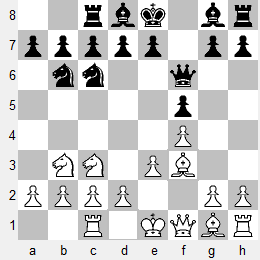Since writing that post, I've had the opportunity to play a few such matches and now have some understanding of the techniques involved. You might assume that playing a two-game match with a random chess960 position is no different than playing a similar match with the traditional start position, but you would be wrong. In the traditional position, you don't care if your opponent opens 1.d4 or 1.e4 as White, or answers your 1.c4 with 1...c5, 1...e5, or any of the other choices. You've prepared for all eventualities and the initial moves are not about seeing which player has the better understanding of chess. That comes later in the game.
In chess960, on the other hand, already in the first moves you're comparing your initial plan as White with your opponent's plan in the other game. It's a contest to discover who has seen more possibilities in the given position.
The match against my strongest opponent started from SP077 NNRBKQBR. A little analysis convinced me that an early f2-f4 (...f5 for Black) is necessary. On top of letting the Bishop out, it gives the Queen a developing square, thereby preparing to castle O-O. The f4 idea was used by both players in both games. An early position in the game where I had Black is shown below, after the moves 1.f4 f5 2.Nc3 Nc6 3.Nb3 Nb6 4.e3 Qf6 5.Bf3. Note that White's last move prepares O-O-O.

What to play next? I looked at a number of ideas. The move 5...e5, developing the dark squared Bishop and setting up tension in the center, suggests itself. I rejected this because after 6.fxe5 Nxe5 7.Bxb7 Rb8 8.Ba6, it involves a Pawn sacrifice. Black gets good counterplay, but I wasn't convinced that it was enough for the Pawn.
More straightforward is 5...Bf7, but I didn't want to commit the Bishop to a passive square while more active possibilities were still available. A similar idea is 5...e6. This might have been the best choice, but I decided against it because of 6.Bxc6 dxc6 7.e4, when White's pieces look more active than Black's.
That last line gave me another idea. If White can give up the Bishop pair so soon, why can't Black? That's how I hit on the idea of 5...Bxb3. After the natural response 6.axb3, White has the open a-file, but it doesn't bring any immediate benefit. In return, Black is confident that White won't castle O-O-O, when the a-file is useless.
After I played 5...Bxb3, my opponent must have reasoned the same way, because he answered 6.cxb3. After a further 6...e6 7.O-O-O Be7, I was happy with my game, and eventually got a small positional plus. I still think 6.axb3 was better, but that would have been a different game.
In the traditional start position, you never have the opportunity to exchange a Bishop for a Knight on its first developing move (except after, e.g. Na3/Nh3, which is decidedly unusual). It's hard to overcome that sort of traditional thinking and look at a chess960 position with fresh eyes, but that's exactly what some positions require.

1 comment:
Mark you've really hit the nail again. I think that the BxN tension in Chess960 is a real challenge to evaluate well and I'm constantly either confused about doing it or deluded about not doing it! This is a classic example of inductive scientific inquiry.
Basically the issue with Chess960 in this age of consumerism is that people want to obtain theory off the shelf preferably for nothing, so that the can deduce winning moves.
Chess960 theory at this stage of it's evolution, is highly inductive theory, and less deductive theory, and so there is little purchasable theory and you have no formula to win other than experimentation and hard work. There is theory, but you can't buy it off the shelf, you have to work at it.
There is no theory in Chess960??....
Rubbish!
There is less deductive theory and more inductive theory in Chess960.....
This is good! It explains why you personally like to play both Chess and Chess960. You personally like both forms of inquiry, deductive and inductive inquiry equally.
For those unfamiliar with the concepts:
Deduction: Working from general theory to specific cases
Induction: Working from specific cases to general theory
Chess is an old game and so it is highly deductive theory. Chess960 openings are new and so it is highly inductive theory.
Enjoy 960
Post a Comment